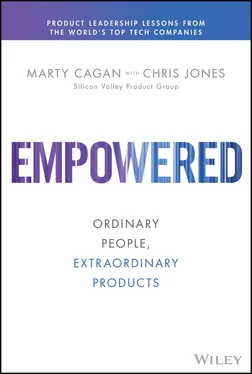1 ...6 7 8 10 11 12 ...18 When you see a reference to a “product leader,” that is normally a manager/director/VP/CPO of product management, manager/director/VP/CDO of product design, or a manager/director/VP/CTO of engineering.
Unless stated otherwise, the advice in the book is aimed at product leaders .
If some advice is aimed at a specific role, such as a product manager, product designer, tech lead, or data scientist, then this will be called out explicitly.
While there is some role‐specific information for product designers and their leaders, and engineers and their leaders, there is more information for product managers and their leaders. This is because, when moving to empowered product teams, the product manager role and the product management leadership role are usually furthest from where they need to be.
Unless otherwise noted, the author's voice is either Marty Cagan or Chris Jones. Both of us are partners at the Silicon Valley Product Group.
We don't call out which person wrote each chapter because we both agree with everything written here, and both of us were involved in the many iterations required to get from the first draft of each chapter to the resulting book.
Further, the lessons shared in this book are drawn from the broader set of SVPG partners. Between all of us, we have well over 100 years of experience leading product organizations at many of the top tech companies.
We are intentionally writing in the first person because we want to come as close as possible to the experience of sitting down with you, the reader, for a series of one‐on‐one coaching sessions, where our only goal is to help you become an exceptionally strong product leader.
How This Book Is Organized
So that you know the range of topics that are coming, here's an overview of the book:
In Part II, we focus on the most important responsibility of strong product leaders, which is coaching and development of the people on the product teams.
In Part III, we discuss staffing these product teams—how to identify, recruit, and onboard these people and ensure they are effective.
In Part IV, we discuss the product vision and principles, which define the future we are trying to create.
In Part V, we look at how we structure the product teams into a team topology that best meets the company's needs.
In Part VI, we discuss the product strategy, which is how we decide which are the most important problems for these product teams to solve.
In Part VII, we convert our product strategy into action through team objectives (problems to solve) for each product team.
In Part VIII, we provide a detailed case study that shows how each of these concepts plays out in practice in a complicated, real‐world situation.
In Part IX, we discuss how to establish the necessary collaboration between the product organization and the rest of the business.
In Part X, we tie everything together and give you a plan for transforming your organization to work the way the best teams and companies do.
While the type of change that is necessary is by no means easy, it is absolutely possible. This book is specifically designed to give you the knowledge and the skills you'll need to succeed.
Coaching is no longer a specialty; you cannot be a good manager without being a good coach .
—Bill Campbell
Bill made this statement years ago, but one of the major learnings of our industry post‐pandemic, is that coaching is more essential than ever. If you hope to innovate at scale, it is simply not optional. Problems escalate faster, relationships are damaged much more easily, and collaboration is harder.
Which is why you'll notice that the longest part of this book is on coaching. That is no accident.
In the technology industry, we focus so much on the core skills and competencies used by product managers, designers, and engineers, but so little on the skills and competencies of managers and leaders. Yet it is these managers and leaders who are responsible for molding people into effective teams.
The logic is simple: Your company depends on successful products. And successful products come from strong product teams.
Coaching is what turns ordinary people into extraordinary product teams .
If a product team is not effective, we need to look hard at the people on that team and see where we can help them improve as individuals, and especially as a team.
The chapters in this part highlight the most important areas of coaching and development for members of product teams. Unless you've been personally coached by an experienced manager, many of the topics may be new to you. Certainly, if you can speak from experience on these topics, so much the better, but if not, it is still valuable to be able to discuss the topic openly. You can learn and improve together.
More than anything, good coaching is an ongoing dialog, with the goal of helping the employee to reach her potential.
CHAPTER 7 The Coaching Mindset
Coaching might be even more essential than mentoring to our careers and our teams. Whereas mentors dole out words of wisdom, coaches roll up their sleeves and get their hands dirty. They don't just believe in our potential; they get in the arena to help us realize our potential. They hold up a mirror so we can see our blind spots and they hold us accountable for working through our sore spots. They take responsibility for making us better without taking credit for our accomplishments .
—Bill Campbell
In this chapter, I'd like to focus not on the people you are trying to coach, but rather, on the necessary mindset of you as coach.
The wrong mindset may lead you to apply these tools in ways that actually undermine their intent.
For example, you may be committed to having regular one‐on‐one meetings with each of your team members, but if these meetings consist primarily of you allocating and prioritizing tasks, they are not helpful—and likely even harmful—as a coaching tool.
A coaching mindset provides a foundation of intent. It is the framing that directs your application of coaching techniques, and your guiding principle for taking action and making decisions around developing a team.
If you are an experienced coach or manager, you may have already developed your own set of principles. If not, or if you are new to management, or if you are responsible for developing a new manager, this chapter attempts to describe the most important guidelines for coaching and management.
Developing People Is Job #1
It's amazing and distressing how few managers actually subscribe to this principle—that developing people is job #1. Most say the right things about the importance of the team, but their actions tell a very different story. They see their accountability for aggregate product outcomes as their most important job and treat their teams as a means to an end.
If you are a manager, you should be spending most of your time and energy on coaching your team. This means expending real effort on things such as assessing your team, creating coaching plans, and actively helping them improve and develop.
You should measure your own job performance on the successes of your team members, even more than the success of your products.
Empowering People Produces the Best Results
Many new managers see their job as driving their team's task list.
This may result in a few short‐term tactical successes, but your product will never reach its full potential if the team is only asked to execute your ideas and actions. More important, you will find it very hard to retain strong people when they have so little sense of ownership over their work.
Читать дальше











